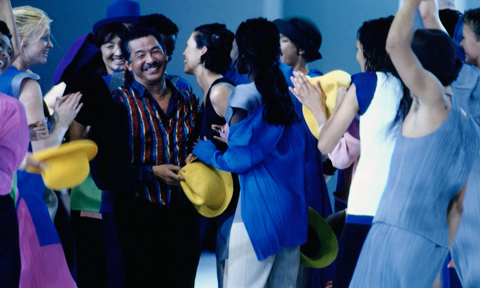
“Design needs to express hope,” Japanese designer Issey Miyake once said about the role of fashion in shaping how humans exist in society. The extraordinary clothing designer and innovator passed away last Friday at the age of 84, following a battle with liver cancer.

Miyake was a pioneer of innovative clothing that felt equally comfortable and stylish.
One of the designer’s most recognisable contributions to the fashion industry were his signature line Pleats, Please where he developed a new way of pleating fabric by wrapping it between layers of paper in a heat press.
READ: Rimzim Dadu On How She Changed The Fashion Industry
This new technique brought about a revolution in the textile industry as Miyake managed to restructure polyester, leading to a shift in the perception of manmade textile. People began viewing polyester as a luxury fabric.
The Japanese designer’s primary focus was always on creating beautiful clothes that people can wear comfortably. Much like Andy Warhol, Miyake was interested in the overlap between art and design, and fashion. Throughout his 52-year career, the designer maintained an ‘anti-trend’ stance, always referring to his designs as ‘clothing’ rather than ‘fashion’.

Miyake designed clothing that was guided by ‘monozukuri’ or his way of making things, rather than what the rest of the fashion industry was doing. His clothing had the versatility to be worn and paired in multiple combinations, with each piece standing out because of its simplicity and beauty of construction.
The designer was born in Hiroshima in 1938 and was just seven years old when the city was destroyed by American atomic bombs. Miyake never spoke about it as he never wanted to be known as “the designer who survived”, instead he channelled that into his designs, as he once said that he prefers to think of things “that can be created and that bring beauty and joy”.

After graduating as a graphic design student in the 1960s, Miyake moved to Paris to work under renowned designers like Guy Laroche and Hubert de Givenchy. By the 1980s, the designer had moved back to Tokyo where he established the Miyake Design Studio.
He quickly became one of the first designers in the world who worked with non-traditional materials to create clothing, including plastic, metals, and traditional Japanese paper. He was once quoted saying, “There are no boundaries for what can be fabric.”
The designer went on to innovate and create clothing that played a huge part in changing the landscape of the industry. Aside from Pleats, Please, the designer was known for his A-POC (A Piece Of Clothing) line, which used a special weaving machine that made outfits of one continuous tube of fabric.

Miyake’s simple yet complex designs caught the eyes of a fellow appreciator of all things pared down, Apple co-founder Steve Jobs. The late designer was asked to design and create the iconic turtle neck jumpers that became Jobs’ trademark style.
He was also awarded the prestigious Kyoto Prize for his dedication to the arts in 2006 and received the Order of Culture in 2010 for “remarkable accomplishment in Japan’s Culture and Arts”.
After his passing, the brand released a statement in tribute to its founder. “Never one to embrace trends, Miyake’s dynamic spirit was driven by a relentless curiosity and desire to convey joy through the medium of design.”
- Quick links
- Issey Miyake
- designers





